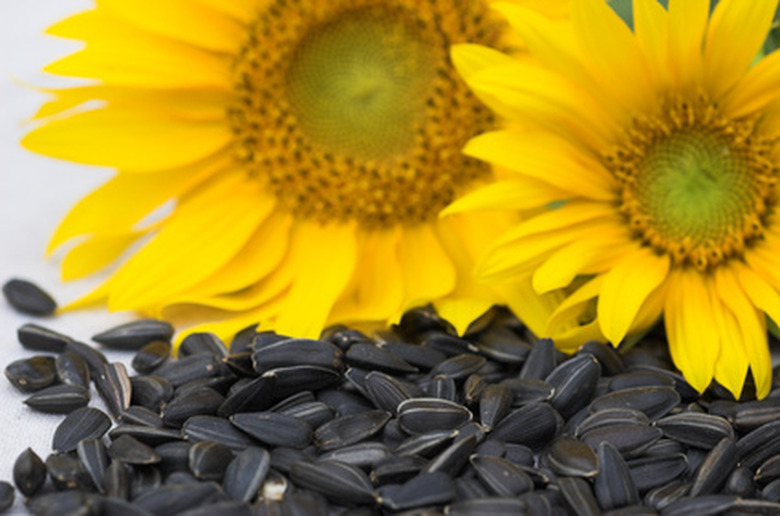How Sunflower Seeds Are Dispersed
The sunflower family, known to botanists as Asteraceae, is the largest family of flowering plants on Earth, including species like daisies, asters and thistles. In some regions, sunflowers account for up to 20 percent of the plant life. Sunflowers share in common a radial flower structure, the petals arranged around the center of the flower like rays around a sun. All flowering plants bear seeds, and seed dispersal is one of the adaptations that account for a plant's reproductive success.
Purpose
When plants first developed seeds, they gained the benefit of extra protection and better nutrition for developing seedlings. Seeds served another purpose, however, in helping plants to distribute their young to more distant locations. Looking at the range of seed shapes in the sunflower family provides a primer of the diversity and effectiveness of seed dispersal methods.
- The sunflower family, known to botanists as Asteraceae, is the largest family of flowering plants on Earth, including species like daisies, asters and thistles.
- All flowering plants bear seeds, and seed dispersal is one of the adaptations that account for a plant's reproductive success.
Airborne
Many members of the sunflower family have evolved parachute seeds easily borne on the wind. These seeds usually form globe-shaped clusters–the dandelion is a familiar example from the sunflower family–that are lifted, caught and carried by the wind, sometimes vast distances. The success of species like the dandelion attests to the success of this particular method of seed dispersal.
Cockleburs
Most cockleburs belong to the sunflower family. The structure enclosing the seeds of a plant that produces cockleburs develops spines, each with a hook at the end. These spines grab hold of just about anything: animal hair, clothing, even the skin on your fingertip. As the host moves to a new location, the seed moves too. Cockleburs have traveled across or between continents, hooked tightly to their animal or human hosts.
- Many members of the sunflower family have evolved parachute seeds easily borne on the wind.
- These seeds usually form globe-shaped clusters–the dandelion is a familiar example from the sunflower family–that are lifted, caught and carried by the wind, sometimes vast distances.
Fruit
While many plants disperse seeds through fruit, this is uncommon among the sunflower family. However, one sunflower species–the boneseed shrub–does produce berries. When eaten by birds or animals, the hard seed inside of the berries passes through their digestive system and is deposited in a new location with the animal's droppings. Ants also like boneseed berries and consume the fruit from around them, discarding the seed to germinate.
Consumption
The word "sunflower" often calls first to mind the enormous yellow flower nodding in the fields during the summertime. These flowers produce edible seeds that are high in energy. At first glance, edibility of one's young doesn't seem to ensure survival of the species, but these sunflowers have demonstrated that it can be. Birds and animals love the seeds but often drop them when carrying them. Other animals horde them, burying them underground and effectively planting a seed to germinate the following spring.
- While many plants disperse seeds through fruit, this is uncommon among the sunflower family.
- At first glance, edibility of one's young doesn't seem to ensure survival of the species, but these sunflowers have demonstrated that it can be.
Significance
Palomar College's Wayne's Word website estimates that there are between 23,000 and 24,000 species in the sunflower family, making it an incredibly successful plant family. The variety of adaptations that sunflowers use when dispersing seeds likely accounts, in part, for this success by allowing sunflower plants to not only protect their progeny but transport them over long distances, constantly establishing individuals in new locations.
